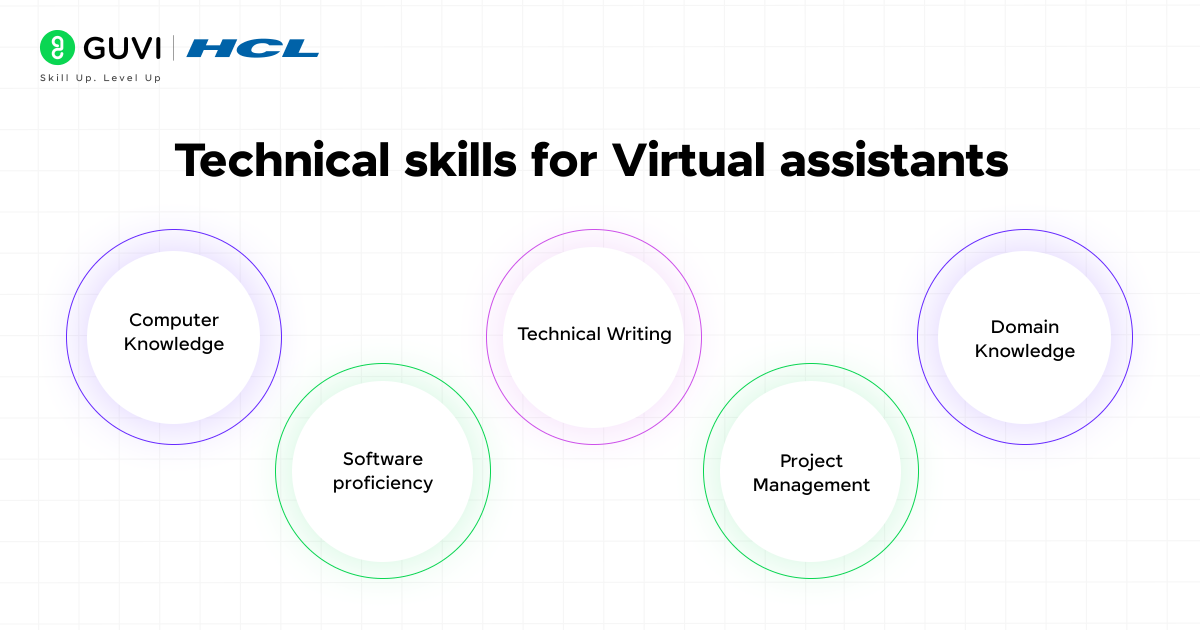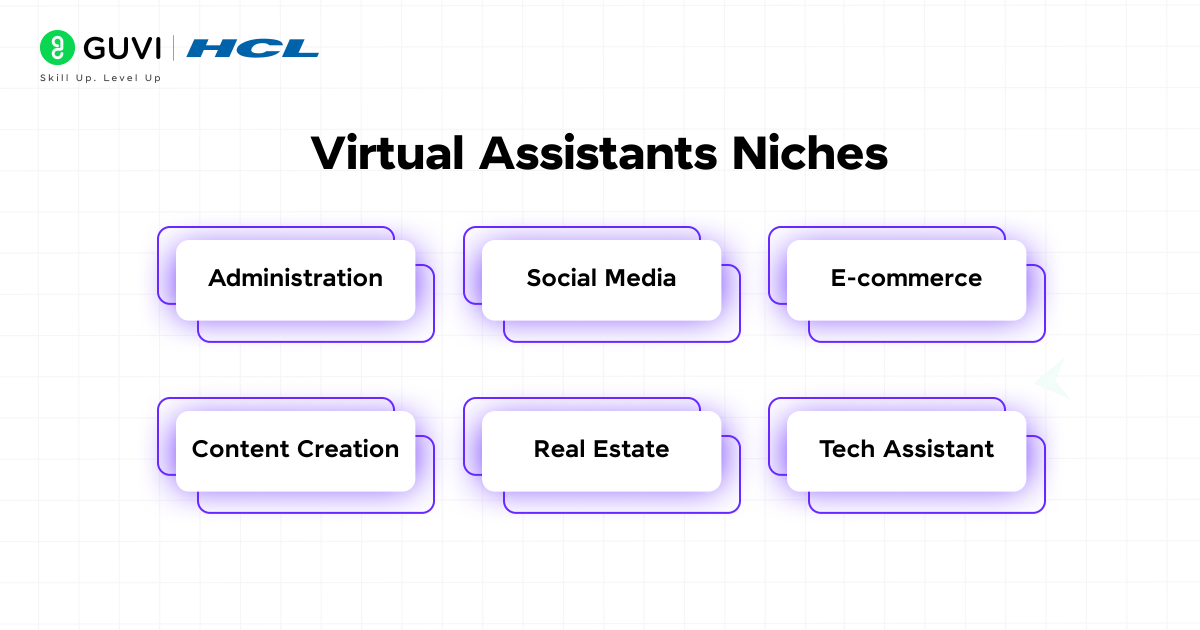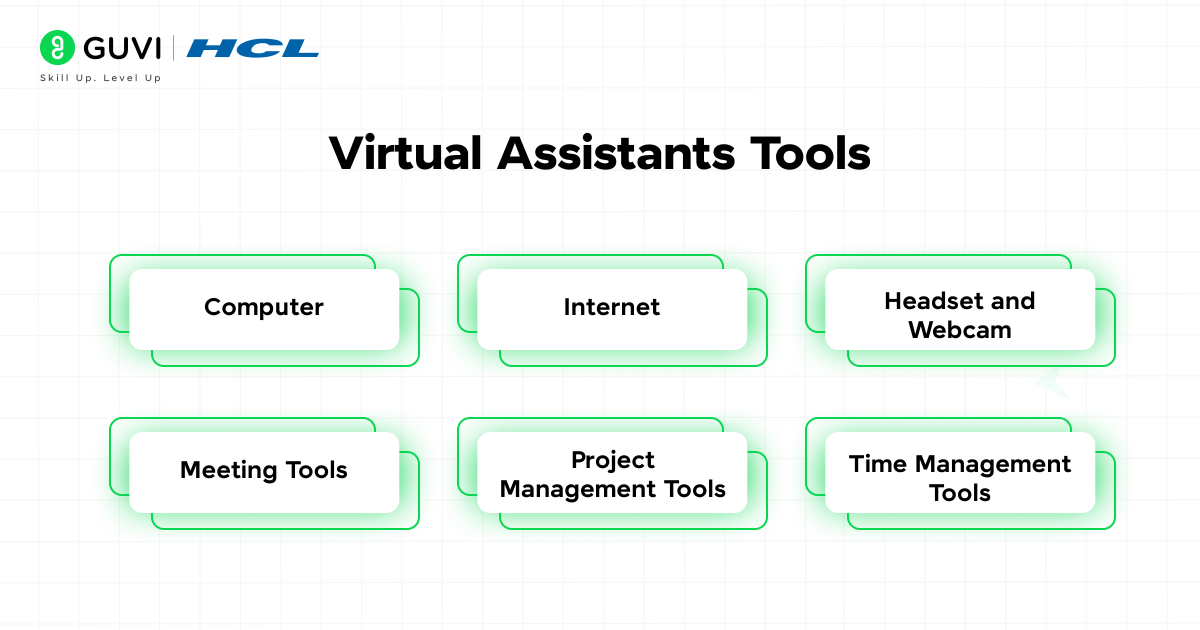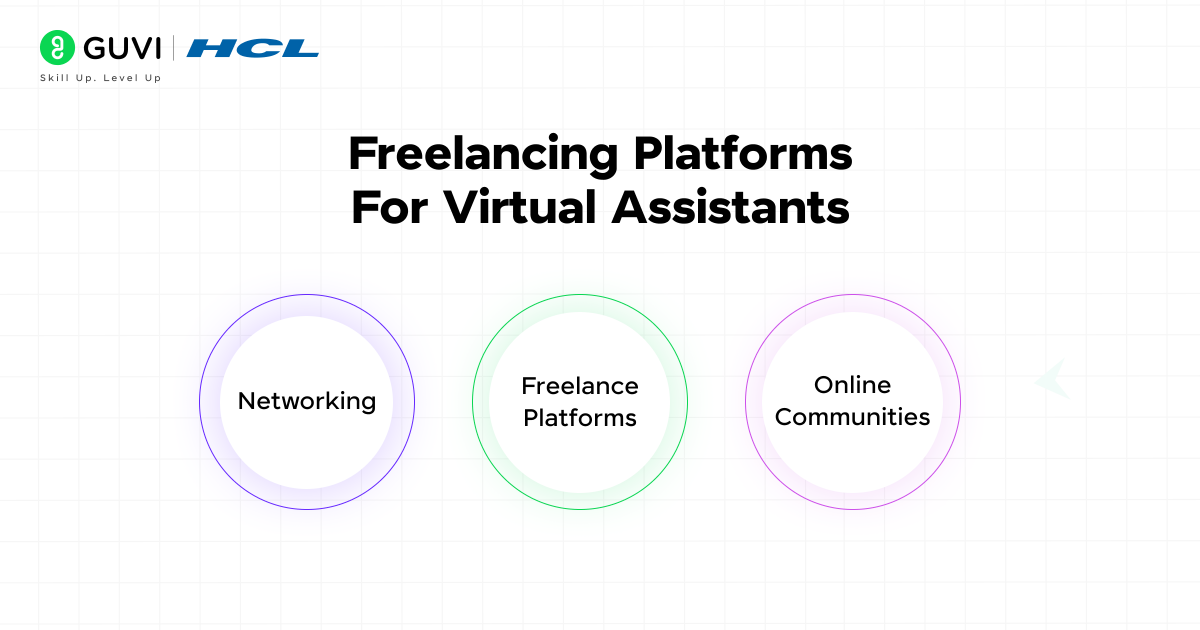
How to become a virtual assistant in 6 Steps
Aug 04, 2025 4 Min Read 1805 Views
(Last Updated)
Are you good at managing your things and being on time for the appointments? Want to become a virtual assistant for others to help them manage and stay about their appointments, but not sure where to start? We got you covered!
In this blog, we will look into 6 simple steps to become a virtual assistant effortlessly. These steps will help you build relevant skills to find your first client. We also provide you with the necessary resources required for each step. If you follow these 6 steps, you will become a virtual assistant in less than 6 months. Let’s get started!
Table of contents
- Who is a Virtual Assistant?
- 6 Steps to Become a Virtual Assistant
- Step 1: Develop Relevant Skills
- Step 2: Choose Your Niche
- Step 3: Set up Your Tools
- Step 4: Create Your Online Presence
- Step 5: Find Your First Client
- Step 6: Deliver the Results and Grow
- Get Started with Guvi
- Conclusion
- FAQs
- Q1. How Hard Is It to Be a Virtual Assistant?
- Q2. How Much Can You Earn As a Virtual Assistant?
- Q3. Where Can You Find Virtual Assistant Jobs?
- Q4. What Services Can a Virtual Assistant Offer?
- Q5. What Skills Do You Need to Be a Virtual Assistant?
Who is a Virtual Assistant?
Virtual assistants are self-employed professionals who provide remote administrative services, technical support, and other assistance to clients online. Their work includes scheduling appointments, making phone calls, and travel arrangements, and managing emails.
Some virtual assistants work in their specialized areas and offer various services related to it. For example, content writers provide services that include but are not limited to blog writing, social media post writing, and bookkeeping. Let’s look at some of the responsibilities of a virtual assistant.
- Administrative Support: A virtual assistant manages calendars to schedule meetings, emails to organize the inbox, and books travel tickets for the clients.
- Customer Support: They respond to customer inquiries via email and phone calls, manage customer service tickets, and follow up with customers.
- Social Media Management: Some virtual assistants specialize in social media management; they create and schedule posts to engage with their followers frequently and track their performance.
- Project Management: With the help of online tools like Trello, Asana, and ClickUp, they coordinate with the team members and track the project deadlines.
These are the common responsibilities of a virtual assistant nowadays. In the next section, we will look into the 6 steps to become a virtual assistant.
6 Steps to Become a Virtual Assistant

This section details the 6 steps to become a virtual assistant. From relevant skills to finding your first client, everything is covered in this section. Stay tuned!
Step 1: Develop Relevant Skills
The first step to becoming a virtual assistant is to learn relevant skills. Skills are mandatory for every role. Most of the companies hire a degree holder as a virtual assistant for their tasks. So, try to complete a full-time degree of your choice, it can be in arts, commerce, or science.
As a virtual assistant, you should have both technical skills to maintain and manage the details and soft skills to effectively communicate with the clients and customers.
Technical skills

Let’s look into the technical skills that a virtual assistant should have.
- Computer Knowledge: A virtual assistant mostly works remotely; they should have a decent knowledge of computers to perform basic level operations such as switching on, off, data entry, and browser activities.
- Software proficiency: As a virtual assistant, you need to work with lots of software to manage your clients’ work.
- Technical Writing: It is a skill that helps document and present your work to your clients.
- Project Management: It is a skill to manage your client’s project from start to finish and follow them along the final deadlines.
- Domain Knowledge: It includes web development, web design, graphic design, artificial intelligence, or mobile application development.
Soft Skills
Soft skills play a crucial role in a virtual assistant role. They need to communicate a lot with their clients, clients’ customers, and their team members for smoother operations. Let’s look into the basic soft skills every virtual assistant should have.
- Communication skills: Being able to communicate in English or the language that a client prefers is important to understand their needs.
- Time Management: A virtual assistant should have great time management to remind their clients about scheduled appointments, meetings, and deadlines.
Step 2: Choose Your Niche

The second step to becoming a virtual assistant is to choose your niche and specialize in it. There are various niches available today, and the availability is also huge. You have to choose your niche carefully, which aligns with your skillset and goal. Let’s look into some of the common and in-demand niches with the services that you can pick up.
- Administration: It includes services such as calendar and email management, appointment scheduling, researching, and data entry.
- Social Media: It includes creating and scheduling posts, responding to comments and DMs, and tracking the performance of posts.
- E-commerce: It includes listing products, inventory management, order processing, customer service, and managing store platforms such as Shopify, Etsy, and Amazon.
- Content Creation: It includes writing blog posts, newsletters, editing, proofreading, and copywriting.
- Real Estate: It includes services such as managing properties, coordinating with clients and agents, and lead follow-ups.
- Tech Assistant: It includes managing CRM tools, website updates, maintenance,e and troubleshooting tech issues.
Ready to become a virtual assistant? Get started on your journey on Guvi with a FREE E-book on Digital Marketing. This E-book will provide you with a detailed roadmap towards Digital Marketing, which includes SEO optimization techniques, Content marketing, social media marketing, email marketing, paid ads, analytics, emerging trends, and case studies, along with their applications in the real world.
Step 3: Set up Your Tools

Once you have chosen your niche, the third step is to set up the necessary tools to begin. As a virtual assistant, your tools are your digital workspace, which helps you to stay organized, communicate effectively, and deliver things quickly to your clients. Let’s look into some of the tools that a virtual assistant requires.
- Computer: You need a laptop or a desktop computer with good speed and storage.
- Internet: You need a stable and fast internet connection for your everyday work.
- Headset and Webcam: You need them for clear communication during meetings.
- Meeting Tools: You need software like Zoom, Google Meet, and Slack for team meetings and communication.
- Project Management Tools: Tools like Trello, Asana, and ClickUp are required for managing tasks and deadlines.
- Time Management Tools: Tools like Toggl and Harvest for effective time tracking.
- Nice Specific Tools:
- Social Media: Canva, Later, and Meta Business Suite
- Content: Grammarly and WordPress
- E-commerce: Shopify, Amazon Seller Central
Step 4: Create Your Online Presence
Once you set up your tools, it’s time to show what you can do to help others. Creating a strong online presence is essential for attracting clients. Let’s look into some of the ways and platforms to create a professional and effective online presence.
- Portfolio: Building a simple portfolio website showcasing your previous works, education, and highlighting your skillset, services, expertise, and contact info is more than enough.
- LinkedIn Profile: It is a powerful platform to showcase your expertise and services to many professionals who need a virtual assistant to help them. Make your LinkedIn profile more professional and highlight your services.
- Social Media: Choose one or two social media platforms related to your clients and showcase your services and skillset.
- Freelance Platforms: Having a profile on freelance platforms such as Upwork, Fiverr, and Freelancer is a great way to make your profile stronger in the self-employment field.
Step 5: Find Your First Client

Once you are all set, the next step is to find your first client. Landing your first client can feel like the hardest part of becoming a virtual assistant. There are many ways and platforms where you can get your first client. Some of them are:
- Networking: As an initial step in finding your client, start by letting people around you know what you’re offering.
- Freelance Platforms: Creating a gig on freelancing platforms mentioned above helps you to get your first client. Highlight your niche, services, skills, and experience.
- Online Communities: There are more online communities and forums where business owners post job leads, and virtual assistants can connect with potential clients.
Try to use all of these resources to post your services and initially offer a starter package to attract your first clients.
Step 6: Deliver the Results and Grow
The last step to become a virtual assistant is to deliver the results on time and grow more in the specific niche. Be consistent in your work and deliver high-quality results. Keep in mind that you have to always deliver things on time, should communicate clearly, be professional, and collect testimonials to feature their project in your portfolio.
These are the 6 steps to become a virtual assistant. In the next section, we will look into the resources for a virtual assistant.
Get Started with Guvi
Due to the recent advances in technology, virtual assistants’ jobs are becoming easier with the help of artificial intelligence (AI). Do you not want to stay behind the AI trend? Start enrolling in Guvi’s course on Artificial Intelligence & Machine Learning, which covers trending concepts such as prompt engineering, Large Language Models (LLMs), and important concepts like data visualization, data analysis, and Python programming.
Conclusion
By following these 6 steps, you can easily become a virtual assistant. Be consistent and confident throughout the process. Focus on a specific niche and practice to become an expert in that particular niche. Once you get good at your niche, try to expand your service by providing domain-specific services. Happy Learning!
FAQs
Q1. How Hard Is It to Be a Virtual Assistant?
It can be challenging at first, but with the right skills and organization, it becomes easier over time.
Q2. How Much Can You Earn As a Virtual Assistant?
The average salary of a virtual assistant in India ranges between Rs. 16,000 to Rs. 35,000 per month.
Q3. Where Can You Find Virtual Assistant Jobs?
You can find virtual assistant jobs on platforms like Upwork, Fiverr, Freelancer, and remote job boards.
Q4. What Services Can a Virtual Assistant Offer?
Services include admin tasks, social media management, customer support, data entry, and more.
Q5. What Skills Do You Need to Be a Virtual Assistant?
Time management, communication, tech proficiency, and organization are key skills for Virtual Assistants.





























It’s a nice one